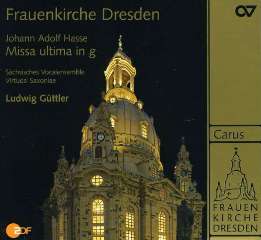Johann Adolph Hasse - Missa Ultima in g (2006)
Johann Adolph Hasse - Missa Ultima in g (2006)

1 Kyrie 1 2 Coro: Christe eleison 3 Kyrie 2 4 Coro (Gloria) 5 Gratias agimus 6 Domine Deus 7 Domine Fili 8 Domine Deus 9 Qui tollis 10 Quoniam 11 Cum Sancto Spiritu 12 Credo: Et incarnatus est - Crucifixus - Et resurrexit 13 Motetto: Ad te levavi 14 Sanctus 15 Benedictus - Hosanna 16 Agnus Dei Ulrike Staude, Barbara Christina Steude - soprano Elisabeth Wilke - alt0 Gerald Hupach - tenor Egbert Junghanns - bass Sächsisches Vocalensemble Virtuosi Saxoniae Ludwig Güttler - conductor rec. Frauenkirche, Dresden, November 2005
This was Hasse’s last completed work and was written in the year of his death, 1783. He was a long admired member of the Dresden court, of course, and the re-consecration of that city’s Frauenkirche gave renewed impetus to the exploration of this, his third setting of the Mass; one that he wrote in Venice.
It’s not a Missa Solemnis as such though it is a big and imposing work written for commensurately large vocal and instrumental forces. It’s tempting to think the Kyrie explicitly Mozartian but it’s necessary to remember that Hasse was born in 1699 and that the fugal procedures Hasse uses are exemplary in themselves and show a debt rather more orientated to Bach than to Mozart. The coro of the Gloria discloses another model, Vivaldi. The Venetian influence on Hasse was distinctive in his later years and this part of the Mass would almost certainly confuse an innocent ear as to the nationality of its composer.
The Gratias agimus is one of the most immediately affecting parts of the Mass with its ascending and descending vocal lines. And in the Qui tollis we can hear another facet of Hasse’s comprehensive skill, his command of orchestral colour. The long bassoon solo, and the rich orchestral brush-strokes, are impressive and the modern instrument Virtuosi Saxoniae play with a sure awareness of important components of historically informed practice.
The brass, percussion and choral writing of the Quoniam are all, once more, fiercely Vivaldian in derivation and orientation though one can detect in the string phrasing of the Credo a distinct Haydnesque influence. There is a consoling duet between soprano and alto but, even more impressive, is the long-limbed and melismatic solo soprano writing in the Benedictus; the solo line here is a constant delight and the orchestral cushion is supple and aerated. This leads to the excellently sprung and rousing Agnus Dei, which ends the work in a spirit of joyous affirmation.
Harmonically and colouristically there is a lot to detain the listener here. The solo lines are often taxing and they’re generally well taken. The bass gets around the notes and rather “chest swells” in the Domine Deus but could be subtler. Otherwise this is a fruitful addition to the recorded repertoire. ---Jonathan Woolf, musicweb-international.com
download (mp3 @320 kbs):








